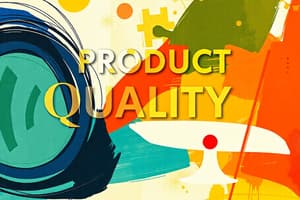Podcast
Questions and Answers
What is the primary driver for companies to focus on comprehensive quality in addition to product quality?
What is the primary driver for companies to focus on comprehensive quality in addition to product quality?
- To decrease the importance of innovation.
- To meet increasing customer demands for flexibility and service. (correct)
- To reduce production costs.
- To simplify the manufacturing process.
A company experiences a significant drop in market acceptance due to negative publicity. Which of these factors is MOST likely to be directly affected?
A company experiences a significant drop in market acceptance due to negative publicity. Which of these factors is MOST likely to be directly affected?
- Internal cost management
- Product development speed
- Employee satisfaction
- Customer trust (correct)
In the context of product liability, what is the MOST important reason for a company to proactively address potential defects?
In the context of product liability, what is the MOST important reason for a company to proactively address potential defects?
- To simplify the auditing process.
- To increase stock prices.
- To avoid potentially extensive claims and associated costs. (correct)
- To reduce marketing expenses.
What is the PRIMARY aim of a product recall action, beyond fixing the immediate defect?
What is the PRIMARY aim of a product recall action, beyond fixing the immediate defect?
A car manufacturer decides to use a less expensive material in the car's chassis to save costs. However, this was not part of the original plan. What aspect of quality management is likely to be affected?
A car manufacturer decides to use a less expensive material in the car's chassis to save costs. However, this was not part of the original plan. What aspect of quality management is likely to be affected?
How did the introduction of the 'Elk test' impact Mercedes-Benz regarding the A-Class?
How did the introduction of the 'Elk test' impact Mercedes-Benz regarding the A-Class?
What was the PRIMARY focus of quality assurance during the Middle Ages through guilds and associations?
What was the PRIMARY focus of quality assurance during the Middle Ages through guilds and associations?
What is the key characteristic of the Taylor system that led to the separation of quality control from production?
What is the key characteristic of the Taylor system that led to the separation of quality control from production?
After 1945, manufacturers began to dictate market conditions and product quality. What was the market primarily driven by during this time?
After 1945, manufacturers began to dictate market conditions and product quality. What was the market primarily driven by during this time?
In a saturated market, what factors MOST influence a customer's purchasing decisions?
In a saturated market, what factors MOST influence a customer's purchasing decisions?
What is the PRIMARY objective of a company focusing on 'external quality'?
What is the PRIMARY objective of a company focusing on 'external quality'?
If a company wants to improve brand image , which type of quality focus (from the perspective of a producer) would be BEST?
If a company wants to improve brand image , which type of quality focus (from the perspective of a producer) would be BEST?
What is the ultimate goal of an organization that prioritizes customer loyalty?
What is the ultimate goal of an organization that prioritizes customer loyalty?
Which underlying strategy does quality control use, unlike quality management?
Which underlying strategy does quality control use, unlike quality management?
What is the direct implication of the 'Rule of Ten' in business economics regarding product defects?
What is the direct implication of the 'Rule of Ten' in business economics regarding product defects?
What is the primary focus of quality management according to Masing's perspective?
What is the primary focus of quality management according to Masing's perspective?
What's the definition of quality management according to DIN EN ISO 9000?
What's the definition of quality management according to DIN EN ISO 9000?
What does it mean that quality depends on many factors?
What does it mean that quality depends on many factors?
Why is it important for management to consider the desires and needs of their employees?
Why is it important for management to consider the desires and needs of their employees?
When focusing on 'machines' and quality requirements, what should an organization consider?
When focusing on 'machines' and quality requirements, what should an organization consider?
What defines the quality and characteristics of end products?
What defines the quality and characteristics of end products?
What is the MOST important consideration when selecting a methodology?
What is the MOST important consideration when selecting a methodology?
What is the role of measurement and testing in the product development process?
What is the role of measurement and testing in the product development process?
What is confirmed when a company determines 'the value or importance of a thing, service, or idea'?
What is confirmed when a company determines 'the value or importance of a thing, service, or idea'?
What's the function of 'management' with regard to quality?
What's the function of 'management' with regard to quality?
In the context of environmental factors impacting quality, what does the term 'Mitwelt' refer to?
In the context of environmental factors impacting quality, what does the term 'Mitwelt' refer to?
What is the main purpose of Quality Function Deployment (QFD)?
What is the main purpose of Quality Function Deployment (QFD)?
What concept is at the core of Total Quality Management (TQM)?
What concept is at the core of Total Quality Management (TQM)?
What is the PRIMARY role of the Balanced Scorecard in strategic management?
What is the PRIMARY role of the Balanced Scorecard in strategic management?
What makes Six Sigma distinguish from other process-improvement strategies?
What makes Six Sigma distinguish from other process-improvement strategies?
What does the acronym DMAIC stand for in Six Sigma?
What does the acronym DMAIC stand for in Six Sigma?
What concept helps in solving problems with continuous improvement?
What concept helps in solving problems with continuous improvement?
What should you do BEFORE using the seven basic quality tools?
What should you do BEFORE using the seven basic quality tools?
What is the PRIMARY goal of a check sheet?
What is the PRIMARY goal of a check sheet?
What's a key benefit of a check sheet over other tools?
What's a key benefit of a check sheet over other tools?
What's the purpose of a Histogram??
What's the purpose of a Histogram??
What is essential before utilizing a 'control chart'?
What is essential before utilizing a 'control chart'?
What role does the Pareto Principle play in Pareto diagrams?
What role does the Pareto Principle play in Pareto diagrams?
Why use a correlation chart/diagram?
Why use a correlation chart/diagram?
When using a brainstorming technique, what is essential?
When using a brainstorming technique, what is essential?
Which tool promotes problem dissection but organizes the probable forces?
Which tool promotes problem dissection but organizes the probable forces?
Flashcards
Umfassende Unternehmensqualität
Umfassende Unternehmensqualität
A comprehensive approach to quality, including flexibility, customer service, reliability, and environmental sustainability.
Kundenvertrauen
Kundenvertrauen
Mistakes can damage this, as bad publicity or negative experiences can erode consumer confidence.
Reklamationskosten
Reklamationskosten
The costs associated with product recalls, warranty claims, and loss of customer trust.
Qualität
Qualität
Signup and view all the flashcards
Qualitätslenkung
Qualitätslenkung
Signup and view all the flashcards
7M
7M
Signup and view all the flashcards
Quality Function Deployment (QFD)
Quality Function Deployment (QFD)
Signup and view all the flashcards
Kaizen/KVP
Kaizen/KVP
Signup and view all the flashcards
Qualitätssysteme
Qualitätssysteme
Signup and view all the flashcards
ISO 9000
ISO 9000
Signup and view all the flashcards
Six sigma
Six sigma
Signup and view all the flashcards
Fehlersammelliste
Fehlersammelliste
Signup and view all the flashcards
Histogramm
Histogramm
Signup and view all the flashcards
Qualitätsregelkarte (QRK)
Qualitätsregelkarte (QRK)
Signup and view all the flashcards
Pareto-Diagramm
Pareto-Diagramm
Signup and view all the flashcards
Korrelationsdiagramm
Korrelationsdiagramm
Signup and view all the flashcards
Brainstorming
Brainstorming
Signup and view all the flashcards
Ursache-Wirkungs-Diagramm
Ursache-Wirkungs-Diagramm
Signup and view all the flashcards
Fehlermöglichkeit- und Einflussanalyse FMEA
Fehlermöglichkeit- und Einflussanalyse FMEA
Signup and view all the flashcards
Study Notes
- Quality is critical for companies to succeed in the international market.
- Customers want comprehensive quality, flexibility, good service, reliability, innovation, and environmental sustainability.
Quality as a Business Risk
- In 1996, poor product quality cost Opel AG 700 million DM in complaints, directly affecting profits.
- Publicly visible problems like fuel tank fires during refueling hurt the brand's image and market acceptance because it stems from internal cost-saving measures in construction and supply.
- A fatal accident in 1985 involving an Audi vehicle with automatic transmission created the impression in the U.S. that Audi vehicles were unsafe.
- There was no technical defect with the gear.
- A recall of 900,000 vehicles was conducted as a preventative measure against liability claims, however, Audi suffered in the American market for years.
Product Liability
- Liability for defective products is becoming increasingly important in the EU.
- Manufacturers are responsible with guarantees and burden of proof reversal.
- In the U.S., product liability cases can be very impactful to manufacturers.
- Massive claims could be made against manufacturers.
Incomplete Specifications
- The A-Class (elk test) from Mercedes, was an example of incomplete specifications.
- New development with no experience in front-wheel drive passenger cars
- The "elk avoidance test" was missing from the specifications.
- There was reduced development time
- There were tight cost specifications
- Caused uncertainty in driving simulations
- Shortened testing time and the application of an outdated rear axle was a cause of incomplete specification
- The rigid trailing arm design saves space but doesn't allow the rear wheels to steer when cornering, and the rear of the car can break out more easily.
- Incomplete specifications caused additional development costs.
- Change costs
- Refitting costs and refitting of delivered vehicles
- The additional equipment costs(ESP as standard) were estimated at 100 million/year
- There were additional marketing costs
- Lost profits by doing away with an optional extra
- Daimler stock dropped temporarily by up to 14%
- Total damages for the group estimated: 600 to 800 million.
- There was an estimated sales loss in 1998 - 20%
- It affected model policy
- ESP is standard for all models
- Annual production of 700,000 vehicles
Historical Considerations
- Quality assurance is an old concept, indicated by seals and trademarks.
- Guilds and professional associations ensured quality of goods and services in the Middle Ages.
- With industrialization in the 19th century, the idea of division of labor and increased productivity came to be through motion and time studies (Taylor, Ford).
- Workers performed few repetitive tasks, requiring less skill but more control, separating work execution from quality control.
- The manufacturer defines the market conditions and thus the quality.
- The customer had little opportunity to influence
Transitioning to Customer Markets
- Styling and quality determine purchasing decisions in saturated markets.
- The customer determines product specifications and considers public interests like environmental protection.
- External quality (product) and internal quality (manufacturing costs) are key to business efforts.
Quality Goals and Success Factors
- Goals include efficient performance, competitive edge, and customer loyalty.
- Success depends on policy, leadership, employee and customer focus, service quality and social responsibility.
Quality Control to Management
- Old strategy ensured a control system of testing at all phases of manufacturing.
- Quality assurance integrated systematic manufacturing processes
- Business insights confirmed that final inspections & rework were inefficient
Quality Influence Factors
- Quality depends on multiple factors
- All factors must meet requirements simultaneously.
- Failure in one factor can lead to insufficient quality.
- The necessary engagement of employees is indispensable for achieving desired corporate objectives with desired efficiency.
Human Factors
- Information gathering, processing, and analysis, high knowledge and technology requirements, increasing interdisciplinary tasks, rapid change in work techniques and tools, high complexity of tasks, constantly increasing performance requirements, cost and time pressure, globalization of work, intercultural division of labor, value change and high flexibility and availability.
- Meeting employee needs helps change and avoids resistance.
Machine Factors
- Not just energy conversion, but accuracy, stability, and maintenance are important.
Material Factors
- End product quality depends on the right material choice, considering suitability, reliability, manufacturability, and cost.
Method Factors
- Success depends on suitability for the task.
Measurability Factors
- Measuring and testing provide data to maintain and improve quality.
Assessment Factors
- Assessing determines the value using criteria like satisfaction, service and reliability.
Management Factors
- Management encompasses strategic and operational control, and coordination.
Environment (Milieu) Factors
- The environment affects measurement and manufacturing.
- Surrounding conditions involving communication, pollution, temperature, lighting and more.
Quality Control and Failure Management
- Quality Function Deployment (QFD) is a method to apply market and customer demands in every level of performance.
Quality Features
- Quality is meeting requirements.
- Only the customer decides.
- Requirements increase.
Kano Model
- Basic features must be fulfilled
- Performance characteristics lead to competitive advantages
- Features to inspire the consumer
Elements of Quality Assurance
- Quality Function Deployment(QFD)
- Kaizen/KVP
- Quality Improvement
Kaizen/KVP
- Continuous improvement needs consistent data tracking, future-oriented measures, and leadership.
- Q Management should strive for continuous improvement & elimination of losses, using a PDCA cycle in all areas.
- Key aspects include customer orientation, TQC, QC circles, suggestions, automation, and more.
FMEA (Failure Mode and Effects Analysis)
- It is created by FMEA teams, to ensure different views.
- Teams answer the questions "where can errors occur, how, what are the effects, and why".
- The system first must limit the errors, and describe the system, all processes, division of elements in groups.
- A failure analysis assigns potential errors to system elements that are seen as limited. and the most important result is the assessment to the people affected by the error.
- The failure risk include likelyhood, consequence, detection of the failure and an impact assessment.
- Should any of the factors be over the accepted level of 125, corrective action should be taken.
- The risk reduction target include avoidence of failiure, and optimization is done according Pareto principle, achieving 80% success.
Risk Analysis
- Risk analysis includes defining machine limits, identifying hazards, assessing risk.
Risk Assessment
- Risk assessment combines damage and probability.
Harmonized Standards are split into A,B, and C
- Type A-Norms regulate all aspects of Machine saftey.
- Type B-norms affect all types of safety measure
- Type C norms are Machine specific.
Quality Systems
- The importance of ISO 9000, it shows the minimum requirements.
- The document follows an 8 step process.
- The 4 main processes of an organizaton can use it.
- ISO-TS 16949, is for series production.
Total Quality Management
- Total Quality Management (TQM) is a management method that prioritizes quality and customer satisfaction, involving all members of an organization.
- It emphasizes cooperation, responsibility, and market orientation.
Balanced Scorecard
- Balanced Scorecard combines strategy and implementation, using traditional financial indicators and customer, process, and learning perspectives.
- Strategies must be converted to measurable indicators.
Six Sigma
- It systematically improves processes used analytic and stattistical methods.
- It uses a 5 phase model to improve processes to eliminate errors, improve resutls and in turn improvign systems.
The 5 Steps of the Six-Sigma are Define Measure Analyse Improve and Control
- All tools assist with problem solving processes, and continuous improvements.
Seven Quality Tools (Q7)
- Easy to use either individually or in teams, helping with solving issues
- Error capture is supported by the method, error cause, Pareto style diagram.
Error Collection
- Easily observe patterns of defects
- Data must eaisly be understood, and easily communicated.
Historgram
- It lets large datasets show a distribution.
- 50 - 100 entries are needed.
Quality Control Chart
- It continuously monitors a process and catches any defects.
Pareto Diagram
- It shows the ABC anaylsis, with 20 procent of causes giving rise to 80 procent of errors.
Diagram
- The correlation diagram illustrates potential effects.
Brainstorming
- It generates ideas
Cause-Effect Diagram
- It supports teams that address the causes of problems.
Studying That Suits You
Use AI to generate personalized quizzes and flashcards to suit your learning preferences.




